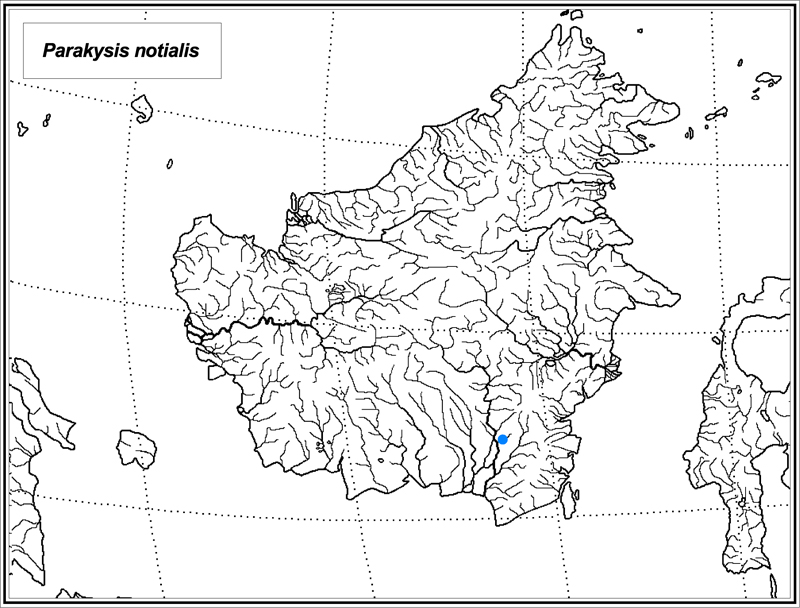Parakysis notialis Ng & Kottelat 2003
Identification: P. notialis has a conical head with small, ovoid eyes. The upper lip has a median lobe projecting into a median concavity on the lower lip. The slightly compressed body and head are covered in rugose skin with small tubercles. The inner mandibular barbel has 2 branches not joined at the base. The outer mandibular has 1 branch at the base. The mandibular latero-sensory canals have 2 pairs of pores; 1 medial to the base of the inner mandibular barbel and another between bases of the inner and outer mandibular barbels. The dorsal fin has 1 spine and 3 rays. The short, robust spine lacks serrations on the posterior edge. The pectoral fin has 1 spine and 5 rays. The short, stout spine has smooth margins without serrae. The pelvic fin has 1 spine and 4 rays. The deeply forked caudal fin has 1 uppermost unbranched ray, 10 branched median rays, and 1 lowermost unbranched ray. Caudal fin lobes are pointed. There are 30-32 total vertebrae, 18-19 preanal vertebrae, and 12-13 postanal vertebrae. The dorsal and lateral surfaces of the head and body are dark brown. The belly, chest, and ventral surface of the head are cream-colored. The body has 5-6 light brown spots on the dorsolateral surface. Anterior � of the dorsal fin is dark brown and the posterior � is transparent. The pectoral, pelvic, anal, and caudal fins are transparent with brown spots that are denser on the rays than on the membranes. The barbels are cream with dark brown rings. Maximum size = 22 mm SL.
Range: This species is found in the Barito River drainage in southern Borneo.
Habitat: P. notialis is found in small forest streams.
Similar species: P. verrucosa and P. anomalopteryx have broadly rounded heads. P. anomalopteryx lacks a lobe on the upper lip and corresponding median concavity on the lower lip, lacks a latero-sensory canal pore between the inner and outer mandibular barbels, and has an unbranched outer mandibular barbel. P. verrucosa often has 11 branched principal caudal fin rays, and the branches of the inner mandibular barbels are joined at the base. P. grandis and P. longirostris have a shorter head, 6-7 pectoral fin rays, a light brown saddle on the back, and a darkly pigmented caudal fin. P. longirostris has an emarginate caudal fin with rounded lobes. P. grandis has secondary branching of the caudal fin rays in specimens larger than 30 mm SL.
Information from:
Ng, H. H. and K. K. P. Lim. 1995. A revision of the southeast Asian catfish genus Parakysis (Teleostei: Akysidae), with descriptions of two new species. Ichthyological Exploration of Freshwaters 6 (3): 255-266.
Ng, H. H. and M. Kottelat. 2003. Parakysis notialis, a new species of akysid catfish from Borneo (Siluriformes: Akysidae). Ichthyological Research 50: 48-51.
